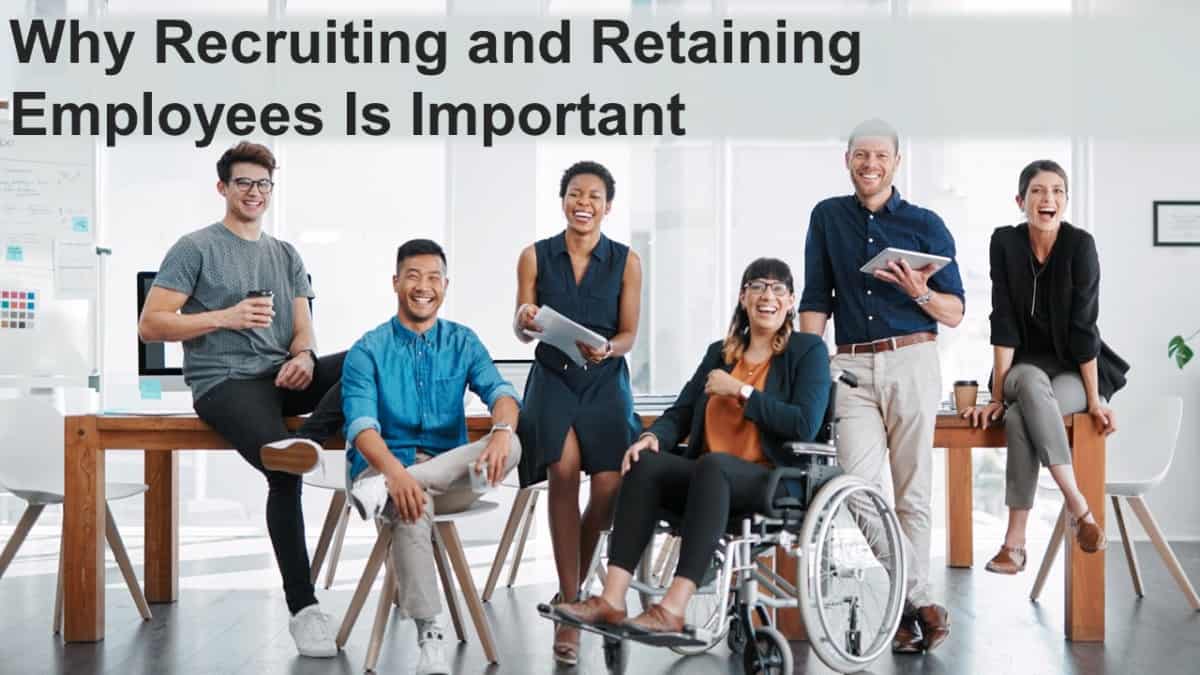Share:
Mark S. Babbitt, Contributor
S. Chris Edmonds, Contributor

As “The Great Resignation” continues, business leaders globally face a harsh reality: Recruiting and retaining employees is more critical today than ever before. And yet, attracting and keeping top talent has never been more challenging for many organizations.
Stuck in what leaders keep calling a “labor shortage,” many companies are cutting back hours and reducing customer commitment levels. Many more are asking employees who stay to work longer hours in less-than-fulfilling circumstances.
Stress levels increase. Burnout becomes prevalent. And, sooner rather than later, more good people leave.
Leaders and HR professionals have heard the estimated cost of replacing a quality employee. According to a pre-pandemic study by the Society of Human Resource Management, that cost is six to nine months of the lost employee’s salary.
But what is the real cost of losing good people and the failure to hire their replacements?
Many use that sole data point as a rallying cry to stop the bleeding—and to keep good people from leaving. However, losing a key employee can’t be measured exclusively by how much it will cost to replace them.
In today’s workplace, there are several under-the-radar factors that make losing good people and failing to compete well for their replacements a significant step backwards for most employers.
Recruiting and retaining employees is important because of the high cost of turnover and its effects on an organization’s productivity, but, more importantly, it’s necessary to ensure continuity, confidence, camaraderie, community, and a strong culture within the organization, which are vital for success.
With that in mind, let’s discuss these five surprising reasons why recruiting and retaining employees is important for an organization’s future.


Continuity
Perhaps the least “surprising” reason recruitment and retention of key employees is vital to businesses today is continuity. After all, legacy knowledge is, for many organizations, the primary source of continuity.
However, as many business leaders are learning, there is more to maintaining continuity than an unbroken existence of people or consistency in operations. This is especially true when circumstances force an end to long-established one-on-one working relationships among employees, team leaders, and managers.
When an influential peer or dynamic leader leaves, there’s a good chance the remaining team members will feel a personal and professional void.
The hardest hit are the employees who see their co-worker or manager as not just an inspiring contributor or leader but a caring mentor. Those employees know their mentor doesn’t just care about the mission and the work.
They care about the person doing the work. They care about them.
When that mentor leaves, a genuine sense of loss occurs. Employees question their desire to work for a new manager. Some dread the need to leverage their knowledge to train a new colleague or to work for a new manager.
Perhaps even worse, employees ask themselves: “If she left… if she didn’t see a reason to stay… should I leave, too?”
Shaken, they question their commitment to their work, team, and company.
Sometimes, despite the remaining team members’ best efforts, their engagement and enthusiasm levels drop. Often, their belief in the mission isn’t as strong as before their mentor left.
Eventually, many employees, now disappointed and perhaps even disillusioned, become casualties of the lack of continuity. They, too, decide to leave. Worse yet, they begrudgingly choose to stay and remain wholly disengaged.
And what began as one person choosing to take their talent elsewhere starts a costly cycle.
Confidence
When charged with a critical deadline, a work team’s collective level of confidence, as well as confidence in the team’s leadership, is a key factor in meeting that commitment.
Additionally, when pulling a new team together to face a rising challenge, each team member’s confidence in themselves and each other quickly becomes a key indicator and driver of success.
In short: People who know each other, or at least their reputation for getting the job done, typically trust each other. From that foundation of trust comes the belief that the team can meet even the most demanding deadlines and find constructive solutions to the most significant challenges.
Let one trusted team member or leader get away, however, and the foundation becomes much less stable.
It’s not that the replacement team member or leader is incompetent, unproductive, or unwelcome. But the team must now navigate technical, operational, and, in some cases, political, learning curves. Simultaneously, the replacement player must develop and maintain their reputation and earn trust.
Yes, depending on the early contributions and the level of Workplace Intelligence (WQ) demonstrated by the new team member, teams can quickly place this less-than-comfortable situation in the rearview mirror.
But that assumes someone else, perhaps due to the miracle that is organizational succession planning, was waiting in the wings, wholly prepared to step into their new role.
What if your company hasn’t yet hired the new contributor? Or onboarded them? What happens to team confidence when the new hire isn’t stepping up, so their peers aren’t yet confident in their ability to contribute?
Employees know. For them, this means an increased workload, more workplace stress, and a higher possibility of burnout, none of which inspires engagement, critical thinking, or commitment.
Soon, they’ll ask themselves: Should I take my talent—and confidence—elsewhere?
Low Performance and Low Values Match
The lower-left quadrant is the worst place for staff to operate consistently. Players in this quadrant often fall short of performance expectations and don’t often demonstrate alignment to values.
Because these players don’t contribute often enough to results or a respectful workplace, one-on-one coaching is required.
If coaching doesn’t improve their contributions to both performance (results) and values (respect), you most likely need to lovingly set them free.
Camaraderie
For decades, old-school leaders have maintained that people don’t need to like each other to work together. To those leaders, only results matter.
So even today, in companies like Amazon and Morgan Stanley, the alpha male leader and lone-wolf-style top salesperson remain celebrated figures; “friendly” rivalries are encouraged.
And yet, a study by Wildgoose found that 57 percent of employees believe that camaraderie, specifically, working with people considered friends, makes work more enjoyable. Additionally, 15 percent said they wanted a workplace best friend but didn’t yet have one.
Another study by Olivet Nazarene University reported that four out of five respondents said they work with at least one person they consider a friend.
So it should be no surprise that workplace relationships are essential when people decide whether to leave (or join) an employer.
Of course, a business leader doesn’t want to be in the position of workplace matchmaking. However, by creating a work environment that encourages the development of mutually beneficial friendships and mentorships, again, emphasizing the critical nature of continuity, organizations can help employees place a “+” in the “Pro” column when deciding to stay or go.
Conversely, a team member who doesn’t feel connected to their co-workers or direct supervisor makes it easy to place a “-” in the “Con” column and makes it easier to move on.
Another benefit to creating a friendly, productive work environment: Employee referrals.
The Olivet Nazarene study shows that six of ten employees with positive relationships at work, regardless of industry or work culture, have actively recruited non-work friends to work at their current company. And as many business leaders know, employee referrals are far more likely to receive interviews and job offers and remain employed far longer than non-referrals.
Enable camaraderie at work. Otherwise, you’ll be on the losing side of unwelcome attrition, and the attraction of top talent will become increasingly difficult.


Community
When camaraderie becomes contagious, a sense of belonging develops.
People become committed to accomplishing a shared mission and the people around them. They know this is the right place for them; they feel good about coming to work every day. They believe leaders and peers hear their voices, that their work matters, and that they matter.
Deciding to leave becomes much more difficult when people feel like they are an integral part of a mission-driven community. Over time, social proof develops. Word gets out that an employer has created a sense of community and a servant purpose—a “reason for being” other than making money.
This employer characteristic is highly-regarded, especially by Gen Y and Gen Z, and becomes a selling point during the hiring process. It helps attract good people ready to do good work for a good cause. Perhaps even better, employees refer friends and colleagues to HR and hiring managers for employment opportunities.
That sense of community doesn’t stop with co-workers, however. It extends to vendors, customers, communities where employees live and work, and global issues like equality, poverty, and democratic access to technology.
When these issues come front and center, employees feel they contribute positively to wellness on a local, regional, and global scale. They feel like they make a difference. As a result, they take bone-deep pride in knowing they work for a reason other than collecting a paycheck or helping their employer maximize profits.
And as has been proven 60 million times since January 2021, people will leave when that sense of community or belonging doesn’t exist, or a servant purpose isn’t present.
They’ll take their expertise where they more closely share common interests, concerns, and values. They’ll actively seek co-workers, leaders, and employers who care about more than making money.
Culture
Our newest book, Good Comes First: How Today’s Leaders Create an Uncompromising Company Culture That Doesn’t Suck, shows that many company cultures are accidental or perhaps incidental. We also make clear that this workplace reality isn’t necessarily the fault of business leaders.
Until very recently, “culture” was no more than a buzzword. So culture leadership was not taught in business school or passed down from predecessors or been-there-done-that mentors.
After all, when it comes to creating uncompromising (purposeful, positive, and productive) company cultures, not many leaders have been there; they haven’t done that.
So at organizations with good cultures, such as St. Jude Children’s Research Hospital, Newell Brands, and Five Below, or bad, such as Uber, The Boeing Company, and The Ellen Degeneres Show, it was easy for company cultures to take on the personality of the founders or CEO.
Especially with the recent transition to remote or hybrid work environments, very few work cultures are intentional, like those at In-N-Out, Bamboo HR, or Consolidated Electrical Contractors.
The loss of talented, engaged people hurts, even more, when companies are not intentionally culture and values-driven.
When highly-regarded leaders, mentors, and key contributors leave a company that hasn’t deliberately invested in their culture, the odds are good that culture, and especially that team’s subculture, will become even more accidental/incidental. Perhaps even toxic.
As many companies have already learned: When good people leave, it’s like they take a piece of the company culture with them.
And if your culture is less-than-inspiring? If your leadership team tolerates, and perhaps even inadvertently rewards, toxic behavior? If employees’ ideas, efforts, and accomplishments aren’t validated and celebrated—daily?
People will find a work culture more aligned with their personal culture. Good people will stay away. And your company culture will most likely—over time—suck.
Recruiting and Retaining Employees: A Top-Down Issue
Yes, the impact of the five issues discussed in this post hit hardest when the most impactful team members leave. Or when you lose top talent to another employer. But as it becomes increasingly difficult for many employers to find and keep good people, that is the point:
Today, one of a leader’s primary responsibilities is to inspire good people to stay and align team members to join.
A leader cannot delegate this responsibility. It can’t be outsourced.
Two years have passed since The Great Resignation began. If the human resources team could have fixed this global problem alone, they already would have. So they need your help and your focus.
In our post-pandemic workplace, retention and recruitment aren’t just leadership issues but top-down leadership issues.
When fellow senior leaders and all other formal leaders see that you care about keeping and attracting good people, largely by emphasizing the critical nature of continuity, confidence, camaraderie, community, and culture, they will care too.
Soon, you’ll have created a company current team members care about enough to stay—and candidates see as the next logical step in their careers.

Mark S. Babbitt is President of WorqIQ, a firm that helps organizations understand leadership’s impact on culture, the company’s collective level of Workplace Intelligence (WQ), and what “good” means to them. He is also the author of the best-selling book, Good Comes First.

S. Chris Edmonds is a speaker, executive consultant, and founder of The Purposeful Culture Group. He’s also the author of two Amazon best sellers: Good Comes First and The Culture Engine.


